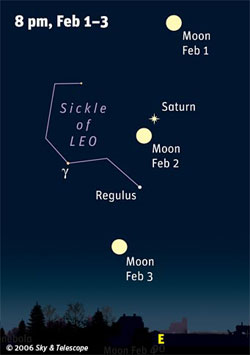 The month's headliner is Saturn, the second largest planet in the solar system. For several months, there were no bright planets well placed in the evening sky.
The month's headliner is Saturn, the second largest planet in the solar system. For several months, there were no bright planets well placed in the evening sky.
The ringed planet is returning to easy visibility in February when it reaches 'opposition' on 10 February-that is, when it is located opposite the sun in the sky. When the sun sets in the west, Saturn will rise in the east. A planet is closest to the earth when in opposition, and so makes for good viewing.
Saturn is near the Sickle of Leo, which imparts an exotic aspect to this well-known asterism. Unlike dazzling Venus and Jupiter, Saturn is faint enough to be mistaken for a normal star-though it outshines nearby Regulus, Leo's brightest, by a factor of three or four.
The ringed world rises at sunset and is out all night, shining at a bright, though not dazzling, magnitude zero. Small telescopes work well to see the rings, which are more edgewise now than they have been in several years, a circumstance that makes Saturn appear only half as brilliant as in recent oppositions. When Saturn rises on the evening of 2 February, the full moon will appear close above it, and the two objects will stay close together through the night.
NASA's Cassini spacecraft is sending back some incredible pictures of swirling clouds and thunderstorms from its current trip around the Saturnian system.
Also early in February, don't miss the solar system's two inner planets at once: the elusive Mercury will be to the lower right of Venus in the twilight. As darkness falls, though, Mercury will set, so make sure you catch it early.
The central landmark of the winter evening sky is the bright constellation Orion, which is currently high in the southeast to south. In its middle is the eye-catching diagonal, three-star row forming Orion's Belt. The lower left of the Belt towards the brilliant Sirius, or Dog Star, the brightest star in the night sky and, at a distance of 8.6 light-years or 50 trillion miles, the closest star.
Other February highlights:
The Sun is in the constellation of Capricornus at the start of February and moves into Aquarius on the 16 February.
Mercury reaches its greatest elongation east of the Sun on
7 February, so there is a chance to see this elusive little planet in the early-evening sky. After this, Mercury disappears into the glare of the Sun again, at inferior conjunction (in front of the Sun) on 23 February.
Venus is now a brilliant Evening Star, and will put on a spectacular show every evening from now right through to summer. On the evening of 19 February, the young crescent Moon will appear close above Venus.
Mars rises in the south-east just as the sky brightens towards dawn, which will make it difficult to see until much later in the year.
Jupiter is coming up in the south-east much earlier than Mars. At the start of February it rises at about 4.30 AM, and will be an hour-and-a-half earlier by the end of the month. By dawn, Jupiter is well up in the south-eastern sky.
Meteors: There are no significant meteor showers in February, and it is a quiet time for sporadic meteors too.


